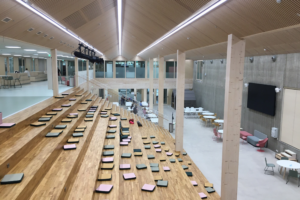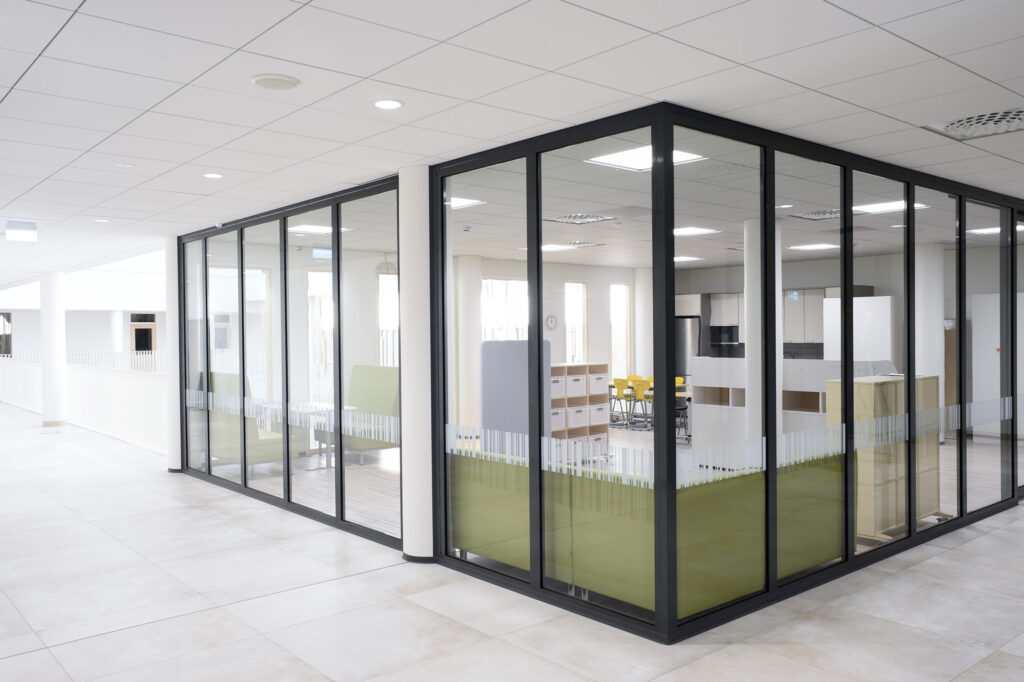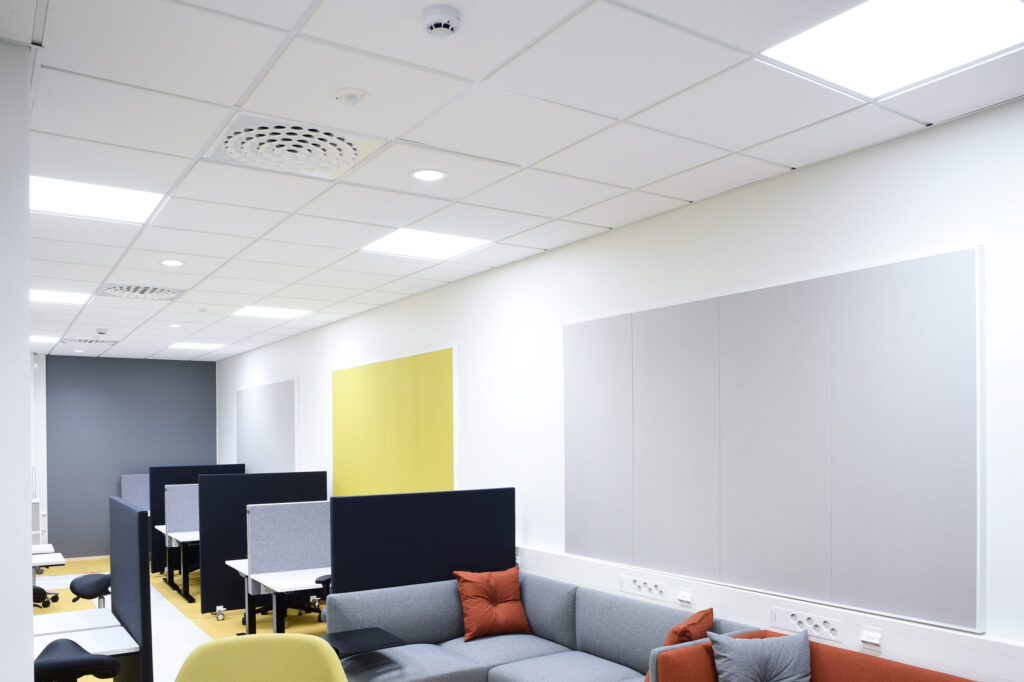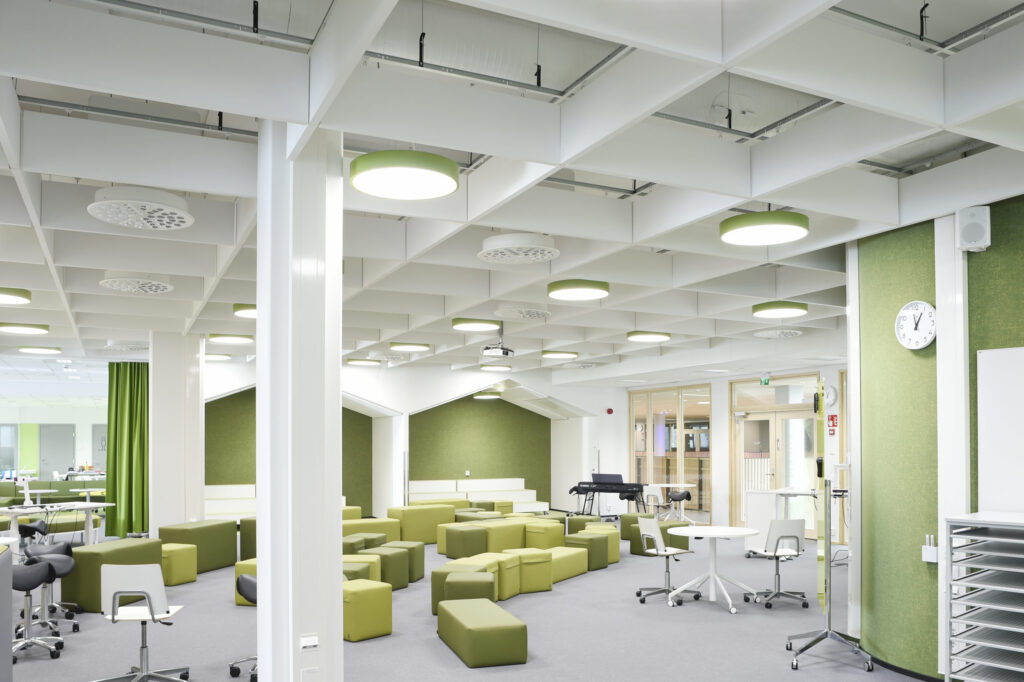
To create a school environment that works well from an auditory perspective, the acoustics must meet the needs associated with the purpose of the premises. Good acoustics are an investment in teachers’ occupational wellbeing, learning and comfort.
“I have teaching spaces that work well for me.“
This is what Heikki Ylhäinen, fifth-grade teacher for a class specialising in music, thought when Finland’s largest wooden school, Mansikkala School in Imatra, opened its doors in autumn 2020.
The music classroom on the second floor is well equipped and the acoustics work well.
“With just one glance through the glass wall I can see whether I can let the pupils do their work in the elementary school’s shared open space.”
In the previous school building, Ylhäinen found himself relatively worn out by the end of the working day. He believes the noise from the corridor was a factor in this. In the new school, sound is absorbed by features such as carpets, soft furnishings and ceiling panels made of porous materials. Fatigue is a thing of the past.
Improvements with acoustic panels and adjustable walls
For Heikki’s wife, class teacher Tiina Ylhäinen, who works at the same school, however, the first academic year in the new school building was relatively stressful.
“Initially, there were too many people in the elementary school, and the spaces had to be used for purposes other than those they were intended for,” she explains.
There are several reasons for the high user numbers: places at Mansikkala School are in high demand, there are more people moving into the area than out of it, and the school centre’s premises ended up being used by pre-school groups for five-year-olds, despite this not being part of the original plan. In addition to all of this, the use of the spaces had to be arranged to accommodate for changes necessitated by the pandemic.

With her second-graders, Tiina Ylhäinen rotated through four different spaces a week, the first being a closed classroom, the second a closed classroom with a through-route, and the third an atrium with a high glass ceiling. The fourth was the elementary school’s shared open space, which hosted several groups working in the space at the same time.
“The atrium is good for quiet working, but it’s too echoey for teaching. The shared open space favoured those with the loudest voice.”
The situation was eased somewhat when some of the teaching groups were transferred to modular units serving as temporary facilities for the duration of the construction work. The teachers’ concerns were listened to, and the acoustics in the atrium improved by installing acoustic wall panels.
This autumn, Ylhäinen got her own classroom that was more permanently separated from the open cloakroom space. Originally, the space was separated with a felt accordion curtain, but due to the poor sound insulation, the curtain was replaced with a glass wall during the summer.
“The open space also had an opening glass wall installed over the summer, which provides sufficient sound insulation for our needs,” says Ylhäinen, emphasising her satisfaction with the new and improved situation.

Shared open spaces accommodate collaboration
Teachers were involved in the design process for the wooden Mansikkala school. However, it proved challenging to visualise the building from the drawings alone. Heikki Ylhäinen remembers that some of the teachers were in favour of walls, but he also understands the pedagogical basis for the design.
“The desire with this school was to move away from traditional class teaching to a more open and collaborative approach, which we’ve explored here with varying degrees of success.”
Both Heikki and Tiina Ylhäinen use the open space in their teaching. The pupils enjoy working on independent tasks in a space where they have sofas and smaller nooks. The couple describe the space as like a library in its atmosphere.
“The pupils are more focused on their work there, as they help each other and consider solutions to their tasks together,” explains Heikki Ylhäinen.
Good acoustics is an investment in the well-being of teachers and students
Whilst acoustic design in schools has progressed immensely over the last decade, the situation still varies between schools. In Finland, every year hundreds of teachers who have lost their voices due to poor acoustics undergo rehabilitation.
The primary sources of problems are echoey environments and hard surfaces. In addition to the sound volume, problems are also caused by noise bouncing around the room excessively. Loud noises can lead to stress reactions in the body, and speech becomes harder to make out.
“Research would seem to suggest that noise influences pupils’ cognitive processes and feeling of comfort,” explains Lecturer and Teacher Trainer Aleksi Lahti of Tampere University Training School.
Lahti has led a number of learning environment projects funded by the Finnish National Agency for Education and steered the modernisation of old classrooms during specialist teacher training organised by the University of Turku.
“Optimising room acoustics is not particularly challenging or expensive, but as a long-term investment it increases occupational wellbeing,” he explains.
Soft surface materials reduce echoing
For lecture-type teaching, spaces where the teacher’s voice carries across the classroom, but without echoing too much, are required. Conversely, for the acoustics in spaces designed for group work and functional teaching, the idea is that the teacher can speak to pupils from a maximum distance of three or four metres away.
Unit Director for Acoustical Engineering Mikko Kylliäinen of the AINS Group explains that echoing can be reduced with soft surface materials.
“Room dividers, such as screens, curtains, furniture and movable walls, prevent noise from carrying between spaces.”

Noise can be made less disruptive with a sound masking system, which uses small speakers to pipe ambient noise into a room. This noise then mixes with and obscures voices from further away. Sound masking systems are in use at both Mansikkala School and Kalliola School in Hollola.
According to Kylliäinen, problems relating to open spaces are often a matter of either not using all of the above means, or the users attempting to use the open space as if it were a normal classroom.

A shared operating culture supports the optimal use of facilities
At Kalliola School in Hollola, the operating culture has been developed purposefully and with a long-term perspective, to support optimal use of the rooms that were completed in 2017 to promote communal and functional pedagogics.
Class teachers Miia Kallio, Pilvi Pesonen and Terhi Rantanen emphasise that a joint approach to planning is key.
The building is divided into four cells, three of which are used for preschool, grades 1–4 and joint grades 5–6 teaching. Each cell has an open space that can be adapted with screens and stools, surrounded by closed classrooms, which can be combined using accordion doors.
Syllabi, staggering of timetables, and activities are planned to keep disruptions to a minimum. At the same time, ideas and thoughts are shared. The plans are updated every autumn to suit the adults’ and children’s needs.
Speaking in open spaces requires practice
According to all three teachers, the soundscape in the cells is calm.
“The noise the sound masking system makes attracted some attention at first, and had to be adjusted a few times to suit the teachers’ wishes. But nowadays you don’t even notice it,” states Rantanen.
The teachers have practised adjusting how they use their own voices in the open space, as well as spending some time considering the issue together. Pupils are reminded to carry out their discussions at volumes that do not disrupt the group working behind the screen.
The guidelines on moving to open learning environments were drawn up by the school’s management, but the teachers’ views have been, and continue to be, taken into account at all stages at the lifecycle school.
A precise needs assessment is important for accessibility
When a school plans a construction project, the intentions when it comes to using the spaces should be stated in the commissioning plan and in the needs assessment.
A particularly precise definition of needs is required when it comes to hearing accessibility: What spaces require induction loops to convey voices to hearing aids? Will confidential activities be taking place in the spaces? Is the intention to divide the space into different parts or use it as one whole? Will electric speakers be used in the spaces?
Principal Minna Kemppainen of Muhos Upper Secondary School, which was completed in 2020, attended a hearing accessibility lecture during the new school’s planning stage to ensure she was aware of what provisions would be needed.
“If the project were starting now, I would ask hearing accessibility experts to assess the school’s needs and equipment at the planning stage,” says Kemppainen.
The upper secondary school has had induction loops installed in its meeting room, hall and lobby, where they work well in serving pupils’ parents and grandparents. However, a pupil who uses a hearing aid would also need the equipment in classrooms.
In light of what she knows now, Kemppainen would have requested information on different loop solutions. Loops are often constructed using old perimeter loop technology, which is not suitable for a school environment and not in-keeping with the guidance of the Ministry of the Environment.
The functionality of loops was measured for hearing mapping.
“The measurements revealed that the loop in the lobby and cafeteria area had been broken during repairs to floor tiles,” explains Minna Kemppainen.
She considers it valuable that the measurements were carried out by a professional who was also able to look at the system from an expert-by-experience perspective.
The problem has now been rectified and the upper secondary school is awaiting maps that will tell hearing aid users where audibility is best in spaces equipped with induction loops.
Text: Katri Puranen
Photos: Ecophon
Sales Manager Pia Laakso and Expert-by-Experience and Founder Mikko Haho of hearing accessibility experts Qlu were also interviewed for this article. Text originally published in Finnish in Opettaja magazine, issue 15/2021: https://www.opettaja.fi/digilehti/oa1521/1-248.

